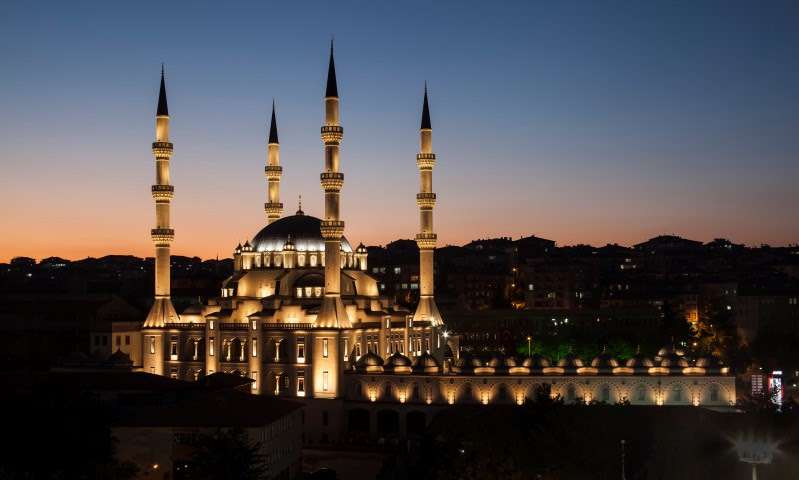Award winning lighting for Kirikkale Nur Mosque
- Details

Inspired by the late Ottoman architecture, the mosque consists of a main dome, eight carrier columns, four secondary domes, five entrance domes and four three-balcony-minarets. The main dome has inner diameter of 20m and height of 32m. The height of minarets is 61m. The mosque is extending in the west and east directions with a domed portico surrounding the courtyard.
The design approach was to emphasize the spiritual identity of the mosque and to create an icon for the city of Kirikkale. On the way to this goal, to enhance the perception of the architecture and to define the structure; main architectural elements were highlighted, shadows were used to give depth, different colour temperatures were applied to differentiate the surfaces and materials. To ensure harmoniousness between illuminated surfaces and to create hierarchy of importance, different wattages and various optics were applied.
‘Light’ and ‘Shadow’ were used to add a mystic appearance to the building and to give form and definition to it by lending contrast at various points throughout the structure. The incidental light from short distance added three-dimensionality to the onion-shaped mini domes on the carrier columns by creating heavy shadows and allowed sparkles on the little crescents. While the half-domes were left in the dark, the patterned windows underneath were lit. The big windows in the lower half of the mosque were accentuated by lightening up with narrow beams, while creating sharp dark surfaces between them. Dramatic effects on columns with muqarnas on top were gained by narrow beams from short distance.
Colour temperatures of light sources were selected in order to create fine gradations between the mosque’s complex surfaces from the bottom up. The main dome was lit from its slopes in cool white and the brass crescent on the top of it and minarets in super warm white, while the carrier columns around the dome and the patterned windows between them were lit in warm white. Inner surfaces of the entrance domes were homogenously lightened with wide beam warm white fixtures whereas the main door has highlighted with a spotlight of super warm white hidden behind the arch. In order to accentuate the patterned rectangle windows in the towers, cool white fixtures placed in the niches whereas the towers themselves were lightened in super warm white with linear narrow beams.
The lighting of the mosque built in the city square was planned in a way that could be perceived from far distances and be the symbol of the city. In order to promote sustainability, lighting levels were limited to that strictly necessary to achieve the aims of the design. Controlled uplighting avoided light pollution and disturbing light spillage to the surrounding, which in turns also helped to prevent unnecessary energy use. In general, energy consumption was minimized by using efficient LED luminaires with right optics and by optional lighting schemes to be applied in different time zones.
To save daylight appearance of the architecture, products were painted in the colour of surfaces and placed in the niches and behind landscape furniture wherever possible.
Kirikkale Nur Mosque was honoured with three international lighting design awards in the architectural facade lighting category: Award of Merit by IALD; Commendable Achievement by A.L Architectural Lighting, and second place in the Darc Awards
“The application of ‘just enough’ light to the exterior and good use of warm and cool sources complements the character of the façade elements,” praised one judge.
In order to be sure about the result of lighting design scheme, the ZEVE design team created detailed 3D modelling of the mosque and got many renderings from different view angles.
“Beautiful, sensitive modelling of the mosque’s three-dimensionality allowed for a lighting solution that enhances the architectural form and shows a considered and successful approach to colour temperature,” wrote another judge.
(Jim Evans)
















